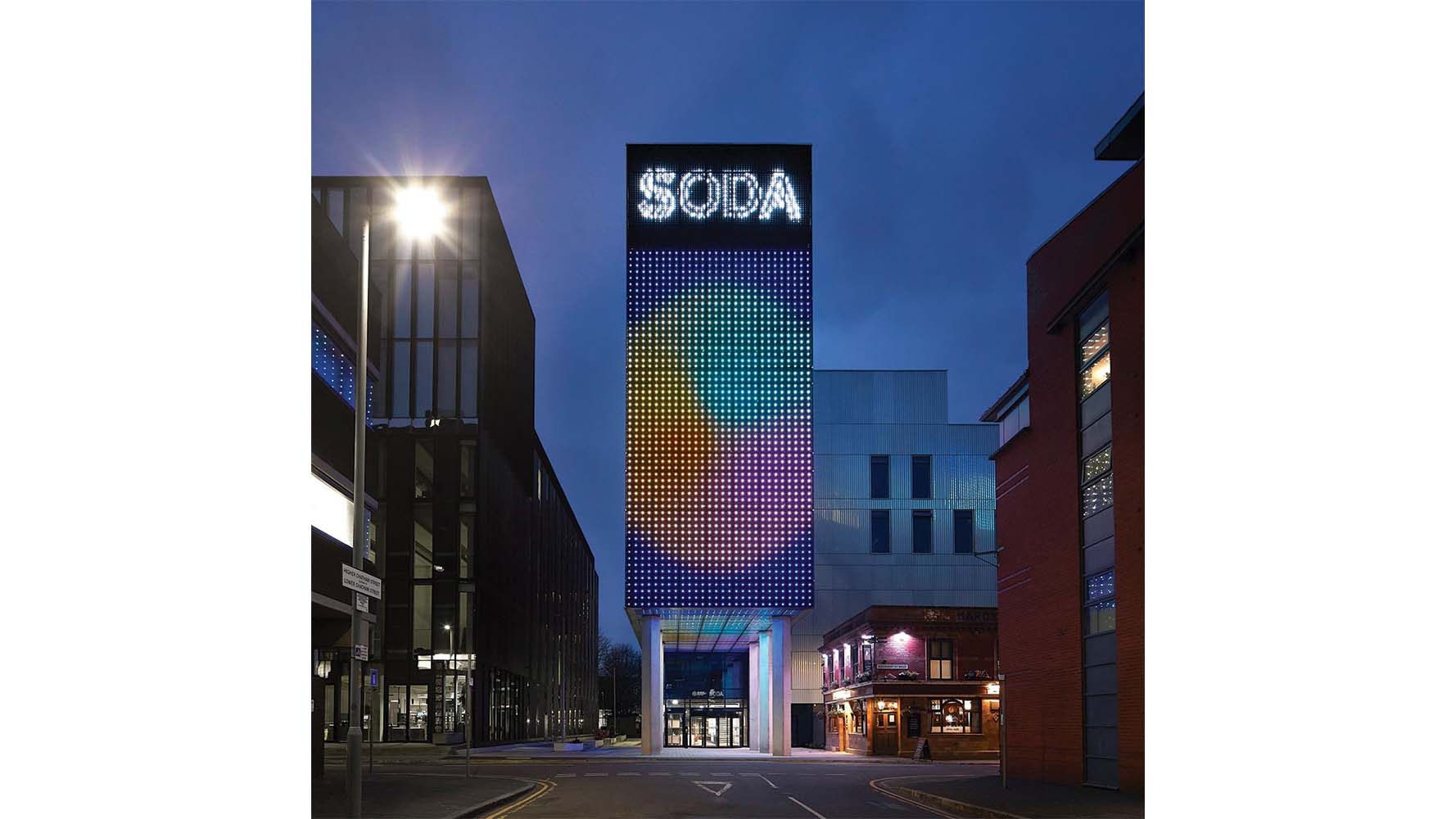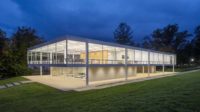The School of Digital Arts (SODA) is a new initiative for Manchester Metropolitan University: a purpose-built home for its existing digital-art and filmmaking programs as well as new courses in game and sound design. A narrow building that sits on what was once a road, the structure is clad in profiled aluminum. “With two darker buildings on either side, we thought of SODA as the cream in an Oreo,” says Steve Wilby, the project architect from Feilden Clegg Bradley (FCB), the firm behind this and other projects at Manchester Metropolitan University. SODA sits between the FCB’s dark anodized-aluminum-clad extension to the Manchester School of Art—completed in 2013 and shortlisted for the RIBA Stirling Prize—to its immediate east and the graphite-hued brick-clad student union to the west, which they also designed, completed in 2014. These are the two “cookies” sandwiching the cream.
The university wanted the new facility to attract as many students as possible, while the staff of the school wanted their building to be visible to the city and to the creative industries that they themselves are engaged in. FCB devised a “light wall” or digital facade that would work toward this end, and also challenge the current students. The dynamic skin, formed from 19,800 full-color LEDs, is a learning tool—or blank canvas—that has been incorporated into the school’s creative curricula, with students already programming such content as a supersized game of Tetris. This not only reflects the spirit of the school but that of the city as well. Manchester is an innovative metropolis, known both for its industrial heritage and the low-fi experimentation of its self-starting music scene.

1

2
An aluminum-mesh screen (1), backed by LEDs, creates a dynamic light wall on MMU’s SODA building (top), an effect brought into the lobby on a digital stair wall (2). Photos © Hufton + Crow, click to enlarge.
The lighting scheme covers five stories of the building’s south face and wraps around the upper east and west elevations to create two “cheeks” or “wings,” each 29½-feet-high by 23 feet wide. It continues underneath the nose of the building, which is raised up one floor on columns, and picks up inside the lobby, where a wall covered with 320 LEDs spans the staircase to the second floor. Capable of creating murals or running animation and video, this dynamic skin is as much an embedded art project as an illuminated facade, operated by an E:cue control platform. And although the current inputs are basic, the system allows for modifications and upgrades.

Photo © Hufton + Crow
Working with lighting consultant Studiotech, the design team devised a simple and efficient distribution of LEDs, spacing them about 4 inches apart around most of the light wall. A 29½- by 16-foot section at the top has a denser array and displays the university logo. Since the lighting scheme is on throughout the day and into the evening (during the school’s operating hours), Studiotech director Ed Vickery says, this configuration “will use around 5 to 7 kilowatts (kW). As a comparison, a household iron is around 2.5kW, so it’s basically like having two irons on at the same time.” The LEDS are partially powered by a photovoltaic array on the roof of the building, which can be doubled in capacity to fully power them if desired.
The screen, and therefore the building, is visible from three sides. Yet the use of relatively low-density lighting, with limited spill, minimizes light pollution for neighboring businesses and residences. In addition, the LEDs are housed behind a perforated-aluminum mesh, meaning that when the screen is off, the facade still looks sharp and clean, with a satisfying contrast to the profiled silver aluminum used on the rest of the building’s facade—not unlike the contrast of silver housing with dark screen on a MacBook.
The light wall gives SODA a spirited face, creating a glamorous plaza—next to the Salutation, a famous old pub—that fits in with the campus collage of architectural styles from Victorian to contemporary. From a distance, particularly the southern approach, the screen may also give the young creatives their first, and perhaps biggest, canvas.
SODA façade sequence. Courtesy Feilden Clegg Bradley Studios
Location:
Manchester, UK
Completion Date:
November 2021
Gross Square Footage:
5,600sqft
Total Project Cost:
£35,000,000
Total Construction Cost:
£22,000,000
Client:
Manchester Metropolitan University
Owner:
Manchester Metropolitan University
Credits
Architect:
Feilden Clegg Bradley Studios
Bath Brewery, Tollbridge Road
Bath, BA1
+44 (0)1225 852545
fcbstudios.com
Personnel in architect's firm who should receive special credit:
Keith Bradley - Senior Partner, Simon Doody – Project Partner, Steve Wilby – Project Architect
Associate Architect(s):
Fairhust Design Group
5th Floor, 31 Dale Street
Manchester, M1 1EY
+44 (0)161 831 7300
http://fairhursts.com/
Engineers:
Structural Engineer: Buro Happold
M&E Engineer: Buro Happold
Consultants:
Quantity Surveyor: Turner & Townsend
Planning Supervisor: Barton Willmore
Fire Consultant: JGA
Landscape Architect: Feilden Clegg Bradley Studios
Planning Consultant: Barton Willmore
Lighting Designer: Studiotech (IBT Group)
General contractor:
Keir
Photographer:
Hufton + Crow, David Berwick
Specifications
Exterior Cladding:
Metal Panels: Maple Sunscreening
Metal/Glass Curtain Wall: Dortech
Rainscreen: Maple Sunscreening
LED Lighting to Façade: Studiotech
Roofing:
Metal: Kalzip Vario
Windows:
Metal frame: Dortech
Glazing:
Glass: Saint Gobain
Doors:
Entrances: Boonedam
Metal Doors: Dortech
Hardware:
Locksets: Glutz Uk
Closers: Glutz Uk
Exit devices: Glutz Uk
Pulls: Glutz Uk
Security Devices: Glutz Uk
Interior Finishes:
Acoustical panels: CMS Danskin
Suspension Grid: SAS International
Studio flooring: Harlequin
Carpet: Heckmondwicke
Music Studios Acoustic Fitout: The studio people
Furnishings:
Furniture: Broadstock
Lighting:
LED screen: Studiotech Ltd
Conveyance:
Elevators/Escalators: Otis








